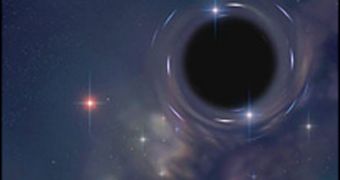Although black hole mergers are very rare in the universe, especially when these processes involve more than two cosmic bodies of this kind, nothing stops scientists from simulating black hole collisions within an artificial environment such as computer models. Researchers from Rochester Institute of Technology's School of Mathematical Sciences report to have conducted, for the first time, a computer simulation involving the merging of three black holes.
"We discovered rich dynamics leading to very elliptical orbits, complicated orbital dynamics, simultaneous triple mergers and complex gravitational waveforms that might be observed by gravitational wave detectors such as LIGO and LISA," says Carlos Lousto, professor in RIT's School of Mathematical Sciences.
According to Lousto, the simulation was necessary because of the find of a triple quasar by a Caltech team led by astronomer George Djorgovki. "This presumably represents the first observed supermassive black hole triple," continues Lousto. The model contained information regarding black holes of equal masses but of different spins and rotations. To make sure that the results are conclusive, the researching team conducted simulations involving the evolution of up to 22 black holes with the help of the 'newHorizon' supercomputer.
"We realized that the code itself really didn't care how many black holes there were. As long as we could specify where they were located - and had enough computer power - we could track them," said Yosef Zlochower, assistant professor in the School of Mathematical Sciences.
'newHorizons' is specialized in computational astrophysics and numerical relativity, meaning it has the ability to test certain predictions made with Einstein's Theory of General Relativity, such as the force required to generate a gravitational wave. Gravitational waves have been intensely studied for the last decade or so, with the help of the Laser Interferometer Gravitational Wave Observatory. However, the detector was unable to filter any evidence of a gravitational wave it might have caught.
A second gravitational wave detector, the Laser Interferometer Space Antenna, is expected to be built in the near future, to continue the work initiated by the LIGO. "In order to confirm the detection of gravitational waves, scientists need the modeling of gravitational waves coming from space," says Manuela Campanelli, director of RIT's Center for Computational Relativity and Gravitation.
To make sure that they do not make the same mistake as in the case of the LIGO detector, researchers must first know what to look for, how would a gravitational wave look like, against the background noise. This is why computer simulations of gravitational wave creation are required.
"Gravity waves can also confirm the existence of black holes directly because they have a special signature. That's what we're simulating. We are predicting a very specific signature of black hole encounters. And so, if we check that, there's a very strong evidence of existence of black holes," concluded Lousto.

 14 DAY TRIAL //
14 DAY TRIAL //